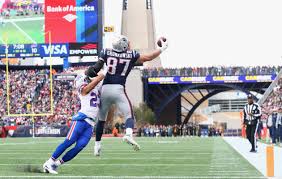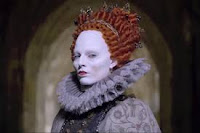
I am going to really
miss Gronk. I think he was probably my favourite active
player, both on the field and off. He is certainly unique, both on
the field and off. Remember when Gronk, trying to speak to an
interviewer in his own language, announced ‘Jo soy fiesta’? It
seems a perfect in-character coincidence that Rob Gronkowski should
retire averaging 69 yards per game, as well as .69 touchdowns per
game, for his NFL career. It’s as if he’s having one last Gronk
laugh as he heads off into the football sunset. ‘Yo soy fiesta’
indeed.
I’m not making
this point facetiously. Well, not totally. Remember back in 2011 when
the pictures of Gronk and porn star Bibi Jones created a furor?
Remember Gronk’s apology for ‘letting down the Kraft family’? I
would say that we live in different times now, considering what the
Kraft family has been up to lately. Remember Gronk’s party ship?
Jerry Jones’ bus got far less attention..

Then again you would
have thought Gronk was Odell Beckham Junior II when the first photos
appeared on the clickbait scandal sites of his partying on a boat
after the Super Bowl (not during the season). It turned out that he
was there with his current girlfriend, ex-Patriots cheerleader and
Sports Illustrated swimsuit model Camille Kostek as well as Jordy
Nelson, his wife Jesse James Nelson, and others, just good wholesome
family vacation, but a lot more fun than the guys from Deadspin have
on theirs.We ought to consider the puritanical quality of the new cyber-wave of Jealousy Journalism.
I mention this
because it seems like one of the most likely paths for Gronk post-NFL
is reality TV of some sort—look what it’s done for Jay Cutler. Or
maybe acting, though guys his size are hard to cast: he was in a
movie called American Violence, and is in one coming out later this
year called Deported in which he plays ‘Party Guy Jake’.
You may recall the
last line of Martellus Bennett’s message to his brother Michael
about his new Patriots teammates? Oh yeah, I forgot Gronk. He’s
smarter than people think.’ Gronk will be able to make money simply
being Gronk. Or Gronky, as Tom Brady’s daughter calls him. I see a
line of children’s shows in the future.
THE ON FIELD LEGACY

Is
Gronk the
Greatest Of All Time? When I wrote a top ten listing last year I had Gronk fifth;
behind Tony Gonzalez, Kellen Winslow, Mike Ditka, and John Mackey (you
can link to that
post here.) I was
assuming his career needed to continue to amass more numbers and
cement a legacy. The way it stands
now, he’s caught in the classic rating dilemma first defined by
Bill James writing about baseball, the difference between career
value and peak value.
I have no problem
calling Gronk the GOAT in terms of peak value. But one of the
interesting things at the tight end position is the way most of the
great ones had very short peaks, because the double burden of
blocking and receiving, especially in the days before multiple tight
end sets and receiving first tight ends came along, wore them down
too quickly. Ditka, who was the prototype Gronk, really had only
3-4 great seasons. Jackie Smith, whose pass-catching style recalls
Gronk’s was the same. John Mackey, Kellen Winslow (number
two on my list) similarly. And Winslow wasn’t the blocker Gronk was
(hint: no great pass catching TEs, save maybe Ditka and Mackey,
were). Antonio Gates hung on for a long time, but at much lower
effectiveness. Gronk ends his career a four-time first-team all pro and with five pro bowls.
On the career side
of the argument, Tony Gonzalez’s 17 seasons of quality receiving
but functional blocking pretty much ensure he’s in first place.
That’s incredibly hard to argue again, though Gronk supporters will
point to the three Super Bowl wins and his incredible post season
stats. Coincidentially, Gronk’s post-season adds up exactly to one
extra NFL season: 16G, 81 catches (130 targets, 62% catch rate) for
1,163 yards and 12 Tds. That’s a first-team all-pro season right
there.
Jim Brown is still
my GOAT running back, and he retired at about the same point in his
career as Gronk did. But his body was not yet in decline, nor had he missed time to injury during his career. Anyone who
watched Gronk this past season could see how much he was slowed by
injuries; you could see the way he had to do a skip to build up
speed. The injury part of his career could be foreseen: he fell to
the second round in the 2010 draft because of back problems he’d
had in college. Of his nine NFL seasons, he played in all 16 games
only twice, and had four other seasons you could call ‘full’
(13-15 games). The other three seasons had 26 games combined.
My call is that at
his peak he is easily the GOAT, given his ability to block anyone,
defensive ends or tackles, linebackers or defensive backs, you could
call him the equal at least of any blocking specialist TE, and
probably the equal of all but a couple of receiving first TEs, and
maybe even more than that given his catching radius, running ability,
and ability to make catches while not being interfered with by
defenders holding and hanging all over him. The NFL’s interference
rule is all about gaining an unfair advantage, and you could argue
Gronk’s abilities meant interfering with him gave defenders no
advantage at all.
For his career, I’m
still torn by that longevity argument, and in the end I might now leave
Gonzalez at number one, and move Gronk ahead of Kellen Winslow, or at
least equal (Winslow was a more transformative player, but Gronk’s
talent is unique) into second. He’s got to be a first-ballot Hall of Famer.
GRONK’S LOSS IN
NEW ENGLAND
While not totally
unexpected, a lot of us thought that as the season grew closer
Gronk's competitive juices would lure him back. He certainly goes out
on a high note: you could make a case for his being the Super Bowl
MVP in Atlanta. But it leaves a huge hole for the Pats, whose draft
strategy has not included a future replacement for him (though I was
highlighting Chicago’s Adam Shaheen in 2017 or Phailadelphia’s
Dallas Goedert, in 2018, as long-term cover --both were smaller college
guys who went in the second round). This surprised me, because the
Pats’ offense is all about mismatches, and Gronk was a human
mismatch with virtually any defender. Remember the stuff they could
do with him and Aaron Hernandez?
With Dwayne Allen
gone to Miami, they have no inline tight end except the recently
signed Matt LaCosse and last year’s seventh round Ryan Izzo, while
the receiving options, Stephen Anderson and Jake Hollister, remain
unproven.
This is a strong
draft for tight ends, but most of them fall in either the receiving
or block-first category. TJ Hockenson will be the first one off the
board because although he’s only 6-4 251, he can do both jobs well.
With the Pats drafting at 32, it would take a steep fall for him to be
available even for a package that could help them move up. George
Fant and Irv Smith are said to be the next two: Smith is the more
willing blocker, but he’s not really an in-line presence; I think
Jace Sternberger might be a better fit. Kaden Smith of Stanford or
Zach Gentry of Michigan might be considerations in round 2 or even 3
if they get lucky. But none is going to step in and start, much less
be a Gronk.

The free agent
market is limited, although the talk is of the Pats managing to snag
Jared Cook away from the Saints, who had seemed to have beaten NE to
the guy who had a fine season receiving last year. Or they could try
to lure Martellus Bennett out of retirement to play with his brother.
Given
that their
wide-receiving corps is very thin as well (2 years/$10m for Cordarelle
Patterson might seem more affordable now that Gronk’s opened up
salary cap room) and with the best remaining free agency Pats-types
being mostly on defense (DE Brent Urban from Ravens, anyone?) it’s
hard to see them getting a big difference maker. They will adjust, as
they always seem to do—last year’s success was as a run-first
team in the last quarter of the season and the playoffs, and despite
losing Trent Brown, Isaiah Wynn is expected to be the starting left
tackle they drafted him to be (with LaAdrian Waddle gone they need a
third tackle now too) – but the question is where the mis-matches
will come from. Gronk’s presence made coming up with them easier: but as
he dashes off into the sunny sunset, yo soy fiesta indeed.
NOTE: This essay was written for my Friday Morning Tight End column at Patreon
You can read it there for free, but subscribe because there will be more to write about in the run-up to the NFL Draft www.patreon.com/mikecarlsonfmte














